Best nutrient-rich aqua soils and inert substrates for planted aquariums
Having a planted aquarium is an excellent way to be closer to nature. Unlike normal fish tanks, to support the healthy growth of the plants in a planted tank, you have to provide suitable substrates for them. In this article, you’ll learn about the roles of substrates for planted aquariums and how to choose the best ones for your tank.
- Best substrates for planted tanks
- Why do aquarium plants need substrate?
- Types of substrates for planted tanks
- How to choose substrates for a planted aquarium?
- Plant aquarium substrate reviews
- Tropica Plant Care Freshwater Planted Aquarium Soil
- Fluval Stratum for planted and shrimp tanks
- Eco-Complete Planted Aquarium Substrate, budget option
- CaribSea Super Natural Peace River Sand
- Seachem Fluorite planted tank substrate
- CaribSea Super Naturals Aquarium Sand
- Landen Aqua Soil Substrate
- S.T International Aqua Soil for aquarium plants
- Mr. Aqua Aquarium Soil Substrate
- Accessories and replacements
- Frequently Asked Questions
Best substrates for planted tanks
| Model | Our rating | Type | For tanks | Weight | Color | pH |
|---|---|---|---|---|---|---|
 |
 Tropica Plant Care Freshwater Planted Aquarium Soil #ad Tropica Plant Care Freshwater Planted Aquarium Soil #ad |
volcanic soil | planted tank | 19.8 lbs (9 liters) | black | neutral to slightly acidic |
 |
 Fluval Plant and Shrimp Stratum #ad Fluval Plant and Shrimp Stratum #ad |
mineral-rich volcanic soil | planted tank, shrimp | 17.6 lbs (4.4, 8.8 lbs available) | black | neutral to slightly acidic |
 |
 Eсо Cоmрlеtе Plаntеd Black Aquarium Subѕtrаtе #ad Eсо Cоmрlеtе Plаntеd Black Aquarium Subѕtrаtе #ad |
rich basaltic volcanic soil | planted tank, established tank | 20 lbs | black | above neutral (not suitable for some acidic water fish) |
 |
 Carib Sea ACS05832 River Sand #ad Carib Sea ACS05832 River Sand #ad |
medium-sized sand (inert) | fish-only, low-tech planted, combine with soil substrates | 5 lbs | brown | not alter |
 |
 Seachem Fluorite #ad Seachem Fluorite #ad |
porous clay (inert) | fish-only, planted tank | 15.4 lbs | brown (black and red available) | not affect |
 |
 Caribsea Super Naturals Aquarium Sand #ad Caribsea Super Naturals Aquarium Sand #ad |
fine sand (inert) | combine with soil substrates | 20 lbs | white (multi colors for choice) | not alter |
 |
 Landen Aqua Soil Substrate #ad Landen Aqua Soil Substrate #ad |
soil | planted tank | 10 lbs | black | slightly acidic |
 |
 S.T International Aqua Soil #ad S.T International Aqua Soil #ad |
soil | planted tank | 11 lbs | black | neutral to slightly acidic |
 |
 Mr. Aqua Aquarium Soil Substrate #ad Mr. Aqua Aquarium Soil Substrate #ad |
soil | planted tank | 2.2 lbs | black | neutral to slightly acidic |
Why do aquarium plants need substrate?

Unlike animals that need food to grow, plants depend solely on the nutrients that they can absorb mostly from their roots. Substrates serve as the base material for live plants in a tank to anchor and develop their roots. Substrates also serve as a store for important nutrients that are necessary for plant growth.
Substrates can be used to control the water chemistry depending on the species that you intend to keep. For example, peat is a good substrate for fish that requires soft water with low pH while other substrates such as carbonate minerals may increase the water pH and hardness.
Substrates also make the aquarium resemble the natural home of fish. It creates a more realistic environment for fish to live in, thereby, contributing to its aesthetic properties.
Furthermore, substrate serves as the house of some useful microorganisms. They help to break down organic substances into nutrients in the form that is useful to live plants. Some play an important role in the nitrogen cycle which deals with toxin ammonia and nitrite in the water.
Types of substrates for planted tanks
An outstanding aquascape starts from the type of substrate you use. You may need to use more than one type of substrate to create the natural appearance in your tank such as depth perspective and contrast. Therefore, let’s talk about the different types of substrate available for planted tanks.
1. Inert substrates
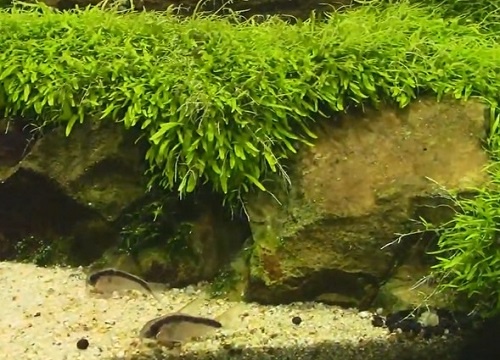
Firstly, let’s talk about inert substrates and their usefulness in a planted aquarium. From the name, it means that they are substrates that are very stable and do not react chemically with the water. They include gravel, sand, and baked clay, which are commonly used to cover the surface of planted aquariums.
Inert substrates are perfect for beginners and are the easiest to manage. They can remain stable nearly forever and may not interfere with the water chemistry. However, planted tanks with only inert substrates would require additional nutrients because these substrates contain little or no nutrients needed for plant growth.
Although inert substrates don’t affect the water chemistry, careful considerations must be made while selecting them. One of the most important selection criteria is size. You should avoid using fine sand in the planted tank as it will block the circulation of nutrients and gases through the substrate. If you have to use a fine substrate, use it as a thin layer on the surface, over other coarser substrates.
Another important factor for selecting an inert substrate is its appearance. The solid colors of most inert substrates make them perfect for beautifying the tank. Depending on your aquascaping goals, the substrate you choose should be such that complements other components in the tank.
A dark-colored substrate could create an amazing contrast with colored plants while a grey substrate could match dark rocks and stones. For instance, black diamond blasting sand would make a unique contrast when used in an aquarium with colored plants.
2. Commercial Aqua soils
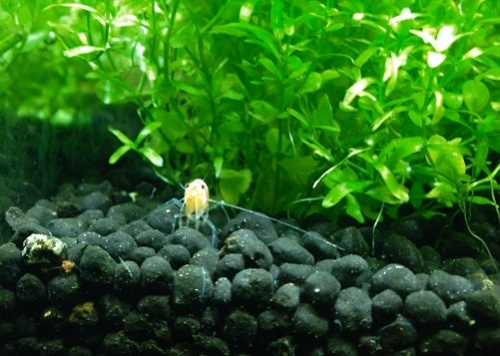
Commercial aqua soils are another type of substrates available for planted tanks. They are made from soil baked into small hard granules.
Compared to raw soil, commercial aqua soils are better for several reasons. Firstly, they are not easily stirred up like raw soil that makes them easier to handle. Secondly, there is consistency with the product, unlike raw soil. Since they are industrially prepared, they would have gone through series of testing and standardization. Therefore, information about the nutrients available in them is usually present.
Furthermore, soil provides a better environment for the growth of useful bacteria. These bacteria break down organic materials in the tank, therefore, preventing them from becoming toxic to the fish and making them available in the form that plants can use.
Many plants will root better in soil compared to inert substrates. Some people use soil as the first layer before using inert substrates so that the plants can root better.
There are some major differences between brands of aqua soil. The first difference is the nutrient content. Depending on the source of the soil and the brand, the organic content, ammonia, and available nutrients would be different. Aqua soil brands also have different buffering strengths. Since most of them contain peat, they can reduce the pH and make the water softer to different degrees.
It’s only a matter of time before the nutrients that are available in the soil exhaust and need to supplement additional nutrients. Aqua soils that contain a high amount of organic matter would require frequent water changes in the first few weeks to prevent ammonia spikes.
How to choose substrates for a planted aquarium?
It must not adversely affect the water conditions
The substrate used for planted aquariums must meet a few criteria. First and foremost, it must not contain elements that adversely affect the water conditions. Most prominent here are coral and seashells, which will raise the pH value and water hardness because of their high calcium content. Other materials that lower these two values can cause the root to rot, which in turn leads to algae growth.
For planted tanks, the pH value of the substrate itself should be neutral to slightly acidic (6.5 to 7), the ideal for most plant roots.
Granule size
The granule size of the substrate should be a combination of 3 and 5 mm to ensure water circulation and good root growth. Smaller granule sizes would easily compact and inhibit the flow of oxygen and other gases while larger granules are not good for root development.
Types of aquarium plants
Next, let’s consider the types of substrate for cultivating different types of aquarium plants. There are three broad groups of aquatic plants classified by root types. These plants all have corresponding substrate needs which must be met.
First are the plants that don’t require any substrate to grow, but instead attach their roots to rocks or driftwood, plants such as Anubias, Microsorium, and Bolbitis. These plants don’t care about the types of substrates you use in your aquarium.
Next are the plants with large rootstocks, like Aponogeton and Nymphaea, and the long-stemmed plants, like Hygrophila and Rotala, that have shallow roots. You will need finer substrate to keep the plants from uprooting.
Lastly, are deep-root plants like Cryptocoryne and Echinodorus. If the substrate is not deep enough for this plant type, the roots will become entangled and the plants, which obtain most of their nutrients and oxygen through their roots, will be asphyxiated. For example, Echinodorus tenellus and E. grisebachii, both of which have long rhizome runners, need at least a 2-inch deep substrate.
When the aquarium contains all three root types, as it often does, it is necessary to create a substrate that will accommodate the deep-rooted plants. You can use a thin layer of fine powder-type soil or fine sand over the regular substrate for gripping shallow-root and carpet plants.
Plant aquarium substrate reviews
Tropica Plant Care Freshwater Planted Aquarium Soil

 Check on Amazon #ad
Check on Amazon #ad
- Type: volcanic soil
- Ideal for: planted tank
- Weight: 19.8 lbs (9 liters)
- Color: black
- pH: neutral to slightly acidic
This substrate is made from Japanese natural volcanic soil and it contains essential nutrients necessary for plant growth. It can be used alone without the addition of any other type of substrate and it is easy for plants to develop roots and absorb nutrients.
It can be used directly from the bag without rinsing and it is good for fish, shrimps, and plants. It also reduces the pH and hardness of water to the level required for optimum plant growth. It is designed to last long and it would hold nutrients thereby making them readily available for plant use.
During the first few weeks, the manufacturer recommends that you should change the water regularly to prevent ammonia spikes. You should ensure your tank is fully cycled before adding fish.
Fluval Stratum for planted and shrimp tanks

 Check on Amazon #ad
Check on Amazon #ad
- Type: mineral-rich volcanic soil
- Ideal for: planted tank, shrimp
- Weight: 17.6 lbs (4.4, 8.8 lbs available)
- Color: black
- pH: neutral to slightly acidic
This is one of the most common substrates used in planted tanks and it is made from mineral-rich volcanic soil with the addition of Fluval micronutrients and macronutrients. It is an excellent substrate for the healthy growth of aquatic plants because it contains all the essential nutrients that aquarium plants would need.
Furthermore, the size of the granule makes it easy for plants to root better in the Fluval stratum and obtain all the necessary nutrients available. Besides making plant roots better, the size of the granule also prevents it from compacting.
The porous nature of the soil also encourages nitrifying bacteria to colonize the surface and make the water quality optimum. Nitrifying bacteria convert the waste product of the fish from the harmful form to a form that is useful for plant growth.
Again, the Fluval stratum is perfect for a tank with newborn shrimps. It provides a refuge for them until they become big enough to avoid predation. Also, it won’t change the color of your water and it reduces the pH slightly for optimum plant growth.
Eco-Complete Planted Aquarium Substrate, budget option

 Check on Amazon #ad
Check on Amazon #ad
- Type: rich basaltic volcanic soil
- Ideal for: planted tank, established tank
- Weight: 20 lbs
- Color: black
- pH: above neutral (not suitable for some acidic water fish)
Eco-Complete planted aquarium substrate is another type of commercial aqua soil that is common in most planted tanks. Just like the Fluval stratum, it is composed of mineral-rich volcanic soil. It is also enriched with natural soil formula to make it imitate the soil of places like Hawaii and Costa Rica that are known to have abundant plant growth.
It contains some important elements such as iron, calcium, magnesium, sulfur, potassium, and over 25 other elements necessary for optimum plant growth. Because of the presence of these nutrients, it is great for the root development of aquatic plants.
It comes with live bacteria that are useful for converting toxic ammonia wastes in the water into nitrites and nitrates, which are less harmful and useful for plant growth. This also makes it a good substrate for an established aquarium in case you need to change the old substrate.
A disadvantage is it supports pH levels above neutral that makes it not suitable for some sensitive shrimp species and acidic-like fish such as discus and neon tetras. However, it is so easy to lower aquarium pH with peat moss.
Eco complete does not contain artificial dye or chemical coatings, therefore, you’re likely not going to experience fluctuation in the water quality while using it. It is an excellent choice for someone on a budget who needs a reliable and ready-to-use planted tank substrate.
CaribSea Super Natural Peace River Sand

 Check on Amazon #ad
Check on Amazon #ad
- Type: medium-sized sand (inert)
- Ideal for: fish-only, low-tech planted, combine with soil substrates
- Weight: 5 lbs
- Color: brown
- pH: not alter
The CaribSea Super Natural substrates are designed to mimic the natural environment of the fish. Having this substrate in your aquarium creates a natural-looking aquascape that resembles the underwater environment.
This substrate is suitable for marine, brackish, and freshwater aquariums. It is ideal for fish keeping and plants can easily root in it because of its grain size. It also reduces the build-up of detritus and fish wastes that can pollute the aquarium.
This is an inert substrate and it doesn’t contain any nutrients for plant growth. However, it is easy for you to dose fertilizers. If your tank has many fish, it is easy to find a suitable fertilizer to grow your plants. Fish wastes provide the plants most macronutrients and the fertilizer supplements the rest.
Another good thing about this substrate is that it has been pre-washed and you can add it directly into your tank. However, it may become cloudy initially but it will clear off after a few hours. It is reddish-brown and does not contain artificial dye or coating. Therefore, it is very stable and does not affect the water pH.
Seachem Fluorite planted tank substrate

 Check on Amazon #ad
Check on Amazon #ad
- Type: porous clay (inert)
- Ideal for: fish-only, planted tank
- Weight: 15.4 lbs
- Color: brown (black and red available)
- pH: not affect
Seachem Fluorite serves both as a beautiful decoration for your aquarium and as a substrate for plant growth. It is an inert substrate and you have to supplement external nutrients to grow your plants. We strongly recommend the Flourish tabs #ad (sold separately) from Seachem. These nutrient tablets contain most nutrients the plants need to grow and are very easy to dose with the careful guide from Seachem.
It is designed for long-term use and doesn’t need to be replaced. Furthermore, this substrate is not chemically treated and won’t affect the pH of the water.
You may notice a slight change in the color of the water initially but it will clear off after some time. Although Seachem Fluorite has been pre-washed, you can reduce the initial change in color by rinsing it before use. Also, you could avoid the initial dirtiness by pouring water slowly over a bowl without disturbing the substrate bed.
CaribSea Super Naturals Aquarium Sand

 Check on Amazon #ad
Check on Amazon #ad
- Type: fine sand (inert)
- Ideal for: combine with soil substrates
- Weight: 20 lbs
- Color: white (multi colors for choice)
- pH: not alter
The CaribSea Naturals Aquarium Sand is similar to the Peace River Sand. The goal of this substrate is to replicate the natural look of the sands found in clear rivers. The crystal white color of the sand makes it a perfect contrast for dark features in the tank. It is perfect when you want to build an underwater river in your planted tank.
Also, this substrate is easy to manage as it does not accumulate detritus and fish waste. It also encourages the growth of nitrifying bacteria. It does not contain artificial dye or chemical coating, therefore, making it a stable substrate.
Landen Aqua Soil Substrate
- Type: soil
- Ideal for: planted tank
- Weight: 10 lbs
- Color: black
- pH: slightly acidic
Laden Aqua Soil Substrate is good for the growth of aquatic plants. It is made from naturally processed soil materials thereby containing essential minerals and elements that promote the healthy growth of aquatic plants.
Besides the availability of essential nutrients for plant growth, its porous nature also encourages the growth of bacteria. Also, plants can easily obtain nutrients from this substrate and develop a good root system.
Although it has been pre-washed by the manufacturer, you could rinse it before using it to reduce the initial cloudiness. It also has good buffering strength and may lower the pH and hardness of the water.
S.T International Aqua Soil for aquarium plants

 Check on Amazon #ad
Check on Amazon #ad
- Type: soil
- Ideal for: planted tank
- Weight: 11 lbs
- Color: black
- pH: neutral to slightly acidic
The S.T International Aqua Soil is specially designed for planted tanks and it is enriched with special nutrients that are perfect for aquatic plant growth as well as fish, shrimps, crabs, crayfish, and snails. This substrate is long-lasting and does not disintegrate easily.
Furthermore, this substrate is ready to use and you can add it to your tank without rinsing it. It has a good buffering capacity and its pH range is 6.7 to 7.0. This means that this substrate would reduce the pH and hardness of the water to optimal levels for plants.
Mr. Aqua Aquarium Soil Substrate

 Check on Amazon #ad
Check on Amazon #ad
- Type: soil
- Ideal for: planted tank
- Weight: 2.2 lbs
- Color: black
- pH: neutral to slightly acidic
This substrate is made with a blend of different organic and inert ingredients, therefore, providing the needed nutrients and a stable substrate for plant roots. It is a good substrate for fish, shrimps as well as aquatic plants. You don’t need to mix it with other substrates as it contains all the essential nutrients required for healthy plant growth.
Also, Mr. Aqua soil has a good buffering capacity and can reduce the water hardness and the pH to a range of 6.6 – 6.8 thereby creating an optimum condition for tropical fish and plant growth. It is designed to last for a long time from 12 months to 18 months.
Accessories and replacements
Substrate divider
Substrate dividers are used to create different zones in your planted aquarium. For instance, a substrate divider would allow you to use different types of substrates without mixing them. Also, a substrate divider would allow you to grow different plants in separate sections of your tank.
Fertilizer
 Seachem Flourish Freshwater Plant Supplement #ad
Seachem Flourish Freshwater Plant Supplement #ad
 Seachem Flourish Tabs, 40 ct #ad
Seachem Flourish Tabs, 40 ct #ad
Plants require nutrients for development and no matter the type of substrate you use, there is a need to supplement the nutrients by adding fertilizer. Soil substrates usually contain enough nutrients to maintain the plants in the first few months. After this time, you need to use fertilizer. Based on the type of substrate you use (soil or inert), you will need different doses of fertilizer.
Cleaning
With time, the aquarium would become dirty and there is a need to clean it up. Some of the aquarium accessories available for cleaning include gravel vacuum cleaners for cleaning the substrate and algae scrubbers and brush for cleaning the glass. You can clean your substrate during water changes.
Frequently Asked Questions
How deep substrate for a planted tank?
The depth of a substrate depends on the size of the tank and the type of substrate. If you have a very small tank, adding too much substrate would limit the space available for other features such as rocks and driftwoods. Also, substrates rich in organic content could easily become anaerobic if it is too deep. Ideally, the substrate for a planted tank should be around 2 to 3 inches deep for plants to root well.
How much substrate to achieve a 2-inch bed?
A good rule to follow is 1 pound of substrate per gallon to achieve a 1-inch bed. Based on this rule, you can calculate the amount of substrate you will need. For example, a 20-gallon planted tank will need 20 x 1 lb x 2″ = 40 lbs to achieve a 2-inch bed.
Could aquarium plants live without substrate?
It is possible to have a planted aquarium without substrate. Some plants such as Java Fern, Mosses, and Anubias can grow without a substrate. They can be attached to driftwoods or rocks in the aquarium. For most stem plants, a good substrate is a must. Although stem plants can survive for a long time without a substrate (free-floating,) their roots can’t develop and they will grow very slowly, even not at all.
How to clean planted tank substrate?
Fish waste and uneaten foods accumulate on the substrate over time. You can clean the entire surface of a planted tank substrate using a water siphon to vacuum away the debris. Reduce the flow of the siphon to not suck up any substrate. Note that water is removed during the process so you’ll have to replace it.
How to change planted tank substrate?
It is possible to change your planted tank substrate. Firstly, remove the fish to a separate container with water to avoid stressing them during the process. Next, reduce the water and remove the old substrate. Vacuum any debris from the base of the tank before you add the new substrate.
We strongly recommend the Eсо-Cоmрlеtе Plаntеd Aquarium Subѕtrаtе #ad as it contains helpful bacteria and will minimize the disturbance of the nitrogen cycle in your aquarium because of the significant change of the substrate.
Cloudy water by the substrate and solution
There are several reasons why a planted aquarium could become cloudy. Knowing the exact cause would help you figure out what step to take. New substrates are usually cloudy and the best solution is to wait for a few hours. If the problem is still not resolved, doing large water changes (30-50%) twice a week at the first 4 weeks may help.
What is a planted tank substrate heater?
Planted tank substrate heaters are placed on the floor of the tank and overlaid with the substrate. Heating planted tank substrate helps with the circulation of nutrients in the tank. Warm water is less dense than cold water and this causes a vertical movement in the tank thereby causing nutrients to circle and avoiding a build-up of harmful wastes in the substrate.


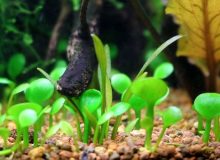
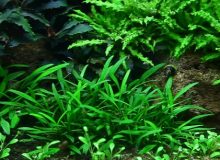
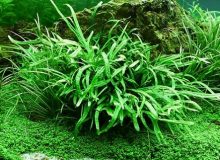
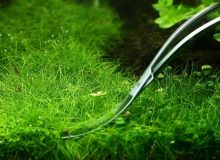
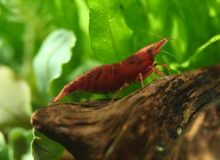
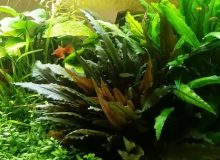
Leave a Reply